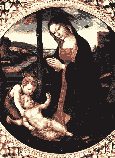|
|
|
|
UfoAmerica
|
http://ufoamerica.iwarp.com |
|
OnLine Magazine
|
$0.00 US,CAN the World |
 Why does this fifteenth century painting depict what appears
to be a UFO in the upper right corner? Does it mean anything at all?
Why does this fifteenth century painting depict what appears
to be a UFO in the upper right corner? Does it mean anything at all?
Aliens with Jesus? by S.S. Collins In a fifteenth century painting by the Italian painter Filippo Lippi, a strange phenomenon has plagued many historians for years. In the upper right-hand corner of the painting that depicts the Virgin Mary and the baby Jesus, there is a strangely anomalous object in the sky. Many have asked, What is it representative of? Moreover, what is its connection, if any, to the baby Jesus? Filippo Lippi painted hundreds of paintings in the early to mid fifteenth century. This painting hangs in the Palazzo Veccio gallery in Florence, Italy. In the upper right section of the painting, a strange object appears to be hovering above and to the right of the head of the woman in the painting. At first glance, it appears to be nothing more then an unimportant spot in the sky, maybe even a bird. Further inspection, reveals something much more bizarre. Behind the woman, there is a man and a dog depicted who appear quite fascinated with this object. Not only are they stopping to look at it, but the man is also pointing at the object in a form of apparent wonder. What could have been flying in the sky at that time that could have brought about such inspiration? Certainly, its inspiration did not come from any modern manufactured aircraft. When the object is blown up, it appears to be circular, with what could be interpreted as an effect signifying atmospheric motion. Possibly, some kind of air disturbance related to the motion of the object. However, what is the object? Some have indicated that this proves there is somehow a UFO connection related to the birth of Jesus. While it is not certain if there is any connection between the baby Jesus and UFO's, I am more concerned with the fact that this object is in the painting at all. Some have said that it is nothing more then an artist's interpretation of a star. However, in all other Lippi paintings that there is a star depicted, not one seems to look anything like the one in this painting. Supposing he was attempting to portray any celestial body, why would he choose black, or dark gray to do so? Would it not seem more likely to use a bright color to represent shinning, or glowing? You would think maybe yellow, or orange, or even white, might be a better choice. It certainly does not seem logical that he would choose to use such a dark color, but then art is always suspect to logic. There are those who claim it could be representative of an eclipse, and that this explains the dark color. It seems viable enough, until you look closely at the object itself. Whatever he was attempting to depict looks nothing like a sun or moon, but rather something within the Earth's atmosphere. How can one make this claim? Well, if you look closely at the blowup of the picture, the object is tilted back in an angle adjacent to the light in the sky. It's off kilter so to speak, and seems easily representative of something that was in the sky, not nessasarily at the time of the painting, but at some time during the artists life. Also, take into account the psychology of the painting itself. Whatever it is, it was significant enough to attract the attention of the man and dog, but not significant enough to attract the attention of the woman fawning over the baby Jesus. Surely, anything like an eclipse or other celestial event like a comet or meteor, would have attracted the attention of everyone in the painting. Such things were considered of the highest phenomenon, since little was understood about the nature and meaning of cosmic events. Whatever it is appears to be a concern to the common person, but not to the holy people represented therein. Obviously, it is not possible to say for sure what Filippo Lippi was attempting to depict in the painting, and this is not the only such depiction from early century art works. Many artists have depicted things such as craft flying, and there is even one Italian fresco that depicts a white bearded man in some kind of flying pointed capsule. It is not possible to determine exactly what these artists were trying to say. We do know that paintings by early man on cave walls clearly depict what today we would call a UFO. We also know that creativity was not very high on the list of attributes for artists such as Lippi. Artists were thought of as recorders of history in early centuries. They tended to pain exactly what they saw. They painted for recording purposes, as much and often more then they did for fun. You be the judge! [ The painting ] [ The blow up ] |
||